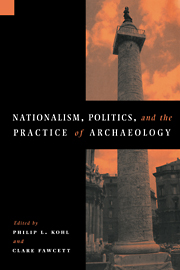Book contents
- Frontmatter
- Contents
- List of maps
- List of contributors
- Acknowledgments
- Part I Introduction
- Part II Western Europe
- 2 Civilization, barbarism, and nationalism in European archaeology
- 3 Archaeology and nationalism in Spain
- 4 Nationalism and Copper Age research in Portugal during the Salazar regime (1932–1974)
- 5 Archaeology in Nazi Germany: the legacy of the Faustian bargain
- 6 Nazi and eco-feminist prehistories: ideology and empiricism in Indo-European archaeology
- Part III Eastern Europe and Eurasia
- Part IV East Asia
- Part V Commentary
- Bibliography
- Index
2 - Civilization, barbarism, and nationalism in European archaeology
Published online by Cambridge University Press: 06 October 2009
- Frontmatter
- Contents
- List of maps
- List of contributors
- Acknowledgments
- Part I Introduction
- Part II Western Europe
- 2 Civilization, barbarism, and nationalism in European archaeology
- 3 Archaeology and nationalism in Spain
- 4 Nationalism and Copper Age research in Portugal during the Salazar regime (1932–1974)
- 5 Archaeology in Nazi Germany: the legacy of the Faustian bargain
- 6 Nazi and eco-feminist prehistories: ideology and empiricism in Indo-European archaeology
- Part III Eastern Europe and Eurasia
- Part IV East Asia
- Part V Commentary
- Bibliography
- Index
Summary
In Europe after World War II overt ethnic chauvinism became politically incorrect on both sides of the Iron Curtain, though for somewhat different reasons. More specifically, the discrediting of Nazi-style racist archaeology made ethnic archaeology (defined below) very subdued. Today, with progressive unification within the European Community, it may be more difficult for states to ignore or to minimize ethnic diversity within or across their borders, while for many in eastern Europe ethnicity has now become a fundamental principle of political identity. In either situation, archaeology may be used as an important aspect of cultural identity and to support moral claims to territory. Territorial claims are unlikely to be settled by archaeological debate, perhaps, but archaeologists and other scholars have provided much ammunition that might be used on the cultural identity front. This might seem odd, if overtly ethnic archaeology has been muted for several decades, and if – as is generally the case – scholars have not fostered ethnicity deliberately in their research or publications. Yet scholars, along with other Europeans, have deeply ingrained perceptions of ethnicity in the European past, perpetuated by traditional terminologies as much as by anything else. A hypothetical, yet characteristic, example may clarify this.
In the two imaginary European countries of Paphlagonia and Crim-Tartary (see Thackeray 1854) the later part of the archaeological record represents documented societies of the historic Paphlagonian and Crim-Tartarian peoples, so the labels “Paphlagonian” and “Crim-Tartarian” are applied to archaeological units.
- Type
- Chapter
- Information
- Nationalism, Politics and the Practice of Archaeology , pp. 21 - 38Publisher: Cambridge University PressPrint publication year: 1996

